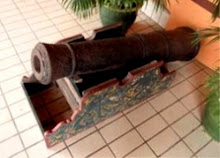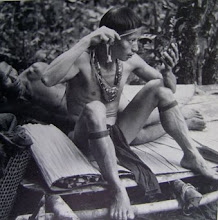When Libau RENTAP realised that it was useless for him to defend the fortress of Bukit Sadok any longer, he commanded his war men to leave it from the opposite side of the mountain. Now the attacking party of Tuan Muda Charles Brooke under cover of the musket shot, rushed over the neck of the rock and entered the fortress through the holes made by the shots from “Bujang Sadok”.
They found that Libau RENTAP and his war men had escaped except for the dead and dying. Inside the fortress they also found the arms captured by Libau RENTAP when he fought against Alan Lee and William Brereton at Lintang Batang stockade in 1853. A large quantity of gun powder and the famous one armed iron cannon named the “Bujang Timpang Berang”. That afternoon the Sarawak Government Forces attacking party burnt down Libau RENTAP fortress at Bukit Sadok. A guns was fired and in ten minutes a tongue of flame shot up into the sky with thick black smokes. At dusk the summit of Bukit Sadok was seen burning for miles and miles away. It marked the end of Libau RENTAP’s power over the White Rajah’s and his long career as a great Dayak Iban war leader where he got the title of Raja Ulu, but he won’t surrender his life to the White Rajah’s.
Libau RENTAP and his war men did not surrender but retreated to Bukit Lanjak Entimau at the headwaters of Batang Skrang, Lemanak and Engkari. He then moved down to the Ulu Entabai the branch of Kanowit and Julau and made another fortress at Bukit Setulak. At his old ages he moved to Karangan Panggil in Ulu Wak, Pakan and died at old ages in the year 1870. He was not buried, but his remains was kept according to the symbol of the Dayak Iban warrior, but honourably laid down to rest in peace in a mortuary known by the Dayak Iban as “Lumbong”.
His tomb, the “Lumbong” is still intact today located at the summit of Bukit Sibau at the headwaters of Budu/Kabo River of Saratok and Wak River of Pakan. His remains was before kept in a large ceramic jar but it was later placed inside a coffin after the reburial of his remains was done in October, 1989 which was done by the Sarawak State Government in the Dayak Iban traditional heroes burial ceremony named Gawai Ngelombong.
Libau RENTAP’s principal enemy, Sir James Brooke the first White Rajah of Sarawak was born in India on 29th.april, 1803. he was proclaimed the Rajah of Sarawak on 24th.September, 1841 and retired due to ill health in 1863, about two years later after the defeat of Libau RENTAP at Bukit Sadok on 25th.October,1861. He died at Burrator, England on 11th.June,1868 at the age of sixty five and buried at Sheepstor Churchyard.
Another principal enemy of Libau RENTAP’s was Sir Charles Brooke, the Second White Rajah of Sarawak who was born on 3rd.June,1829 at Berrow Vicarage near Burnham, Somersethire, England. He was proclaimed Rajah in place of his uncle Sir James Brooke on 3rd.August,1868. he died on 17th.May,1917 at ther age of eighty eight and was buried beside the tomb of his uncle, Sir James Brooke.
Nanang who plaed a key role at the time of the final Sadok War Expedition on 28th.October,1861 received his father’s title of “Orang Kaya Pemancha” from the Second White Rajah, Sir Charles Brookeat a ceremony at Fort Alice at Simanggang (now known as Sri Aman) in 1882. he served the Government Of Sarawak as a member of the Supreme Council representing the people of Upper Saribas until his death in 1901. he was succeeded by his son, Penghulu Insoll of Buloh Antu, Padeh until 1912.
Libau RENTAP was a man of principal. He swore that he would never see the face of a White Man again in his life. He met several defeats but never surrendered. He had been branded as a great rebelious Dayak Iban War Leader, hunted high and low and yet he manged to live until he met his natural death during the period of his retirement from active war fighting. He fought gallantly defending his country land and his people from several attacks made by the intruders until his whole power was broken on 28th.October,1861 but not his life.
His name is still mentioned and remembered today as a great Dayak Iban Chief and Dayak Iban War Leader and aslo the the Hero Of Bukit Sadok in the history of Sarawak and Malaysia.



































